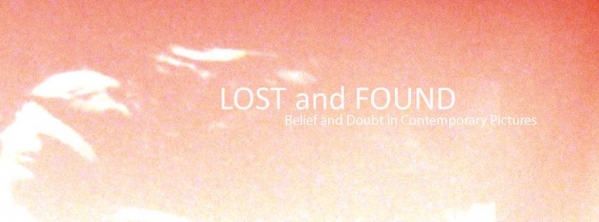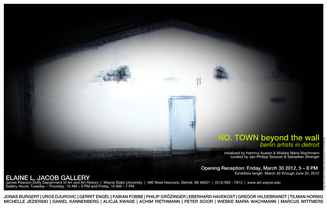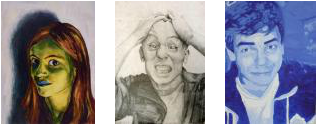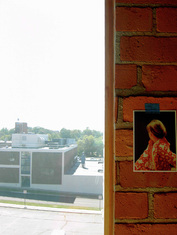|
PASSENGER Presents:
LOST and FOUND: Belief and Doubt in Contemporary Pictures Curated by Brian Barr April 5- May 6, 2012 Temporary Project Space 1261 Woodward, Detroit, MI Opening reception April 5, 2012, 6-8pm LOST and FOUND: Belief and Doubt in Contemporary Pictures marks the public launch of programming for PASSENGER, which will be a residency program and project space in Detroit. This show announces the vision, goals and type of ideas that PASSENGER seeks to support while we work towards establishing a permanent location. Showcasing the best local artists in the context of top emerging practitioners from around the country, LOST and FOUND looks at artists engaging with the concept of pictures in the era after the "death and resurrection of painting" in which images in any traditional capacity have become impossible in a critical context. In light of this impossibility comes the demand for a fresh investigation. LOST and FOUND showcases a generation of artists that are aware of the historical critique of the language of painting/images. This awareness informs their practice and a traversal of the liminal space between belief/doubt structures their conceptual framework. The artists exhibited are Njideka Akunyili (New York, NY), Hartmut Austen (Detroit, MI), Jordan Buschur (Lincoln, NE), Tim Campbell (Washington, D.C.), Jesse Harrod (Chicago, IL), Yui Kugimiya (Brooklyn, NY), Doron Langberg (New Haven, CT), Nick Martin (Carbondale, IL), Ryan Parker (Philadelphia, PA), Lauren Rice (Detroit, MI), Amy Sacksteder (Ypsilanti, MI), Naomi Safran-Hon (Brooklyn, NY), Sharon Servillio (Queens, NY), SLINKO (Brooklyn, NY) More info HERE March 30 - June 22, 2012
Opening Reception: Friday, march 30, 5-8 PM Elaine L. Jacob Gallery, 480 W. Hancock, Detroit MI 48202 NO.TOWN beyond the wall Two decades after the fall of the wall - Berlin artists meet Detroit. Detroit’s creative community has long investigated the commonalities and differences between Detroit and Berlin. The most obvious commonality may be that both cities were the base of large industries that have drastically diminished or even vanished. In Detroit, the American automobile industry now shadows its former self in terms of size and influence. In Berlin, the loss of industry such as AEG is a consequence of National Socialism, war and separation. The two cities share physical characteristics as well. The Berlin Wall was a highly protected and dangerous border that cut the city and Europe into two parts. Detroit’s Eight Mile Road marks the economic divide between the impoverished city and its affluent suburbs. Both cities have been demarcated and divided with distinct populations in direct proximity while remaining separate, not only physically but psychically. In the recent past, however, after the fall of the Iron Curtain in Europe and the election of a black President in the US, previously fixed borders have become more permeable, creating free spaces and open areas. Though welcome, this new phase is accompanied by an atmosphere of dreariness that has become the ground for new forms of cultural and social exploration by pioneers of contemporary culture. In Berlin and Detroit, many artists have moved into abandoned industrial buildings in the search of studio spaces to create art and to start small businesses. The rich but neglected architectonic legacy is often an added incentive for new kinds of uses. For example, in the early nineties the former vault of the department store Wertheim in Berlin became home to one of the most famous techno clubs in the world, called Tresor. The Tresor is strongly influenced by the roots of Detroit techno music. The changes over the past twenty years have been dramatic. The selected artworks reflect the personal experiences of fifteen artists, each with an idiosyncratic perspective. Urban environments and changing cultures are presented without any attempt to generate sanitized or homogenous pictures. No. Town stimulates visual experience, thought and conversation. The following artists are featured in the exhibition: Jonas Burgert, Uros Djurovic, Gerrit Engel, Fabian Fobbe, Philip Grözinger, Eberhard Havekost, Gregor Hildebrandt, Tilman Hornig, Michelle Jezierski, Daniel Kannenberg, Alicja Kwade, Achim Riethmann, Peter Scior, Wiebke Maria Wachmann and Marcus Wittmers. Potential is a juried exhibition that showcases the work of Washtenaw County high school artists. This exhibition has a 30 year tradition at the Art Center. The purpose of Potential is to display original pieces of high school art work that represent the highest achievements in any art medium. Works that clearly represent achievements in creativity and transcend the usual class projects and assignments This year's Juror is Hartmut Austen a nationally exhibiting artist and educator. In 2009 he was awarded a prestigious Kresge Art in Detroit Fellowship. Currently, he teaches at College for Creative Studies, Wayne State University, Eastern Michigan University, and is also an Instructor of painting at Interlochen Summer Arts Camp. Juror Hartmut Austen will be leading a student portfolio workshop and giving a short lecture on Saturday, March 24th from 2-3 PM. Parents are encouraged to attend. The Awards ceremony takes place at 3:30PM during the Opening Reception. |
AuthorHartmut Austen is a painter and educator currently based in the Boston area. Archives
February 2023
|




 RSS Feed
RSS Feed